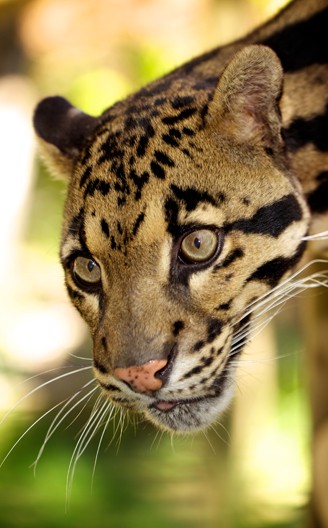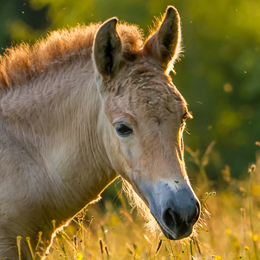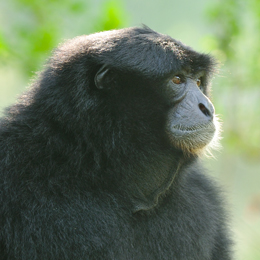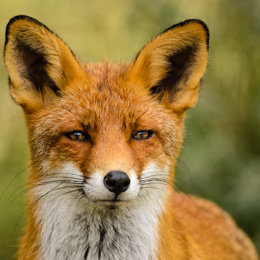Description
The species N. Nebulosa gets the name clouded leopard due to the cloudy patches on its skin. In China, this leopard is also known as the mint leopard as the patches on its fur sometimes resemble the shape of mint leaves. Adult males of this species can weigh up to 25 Kg while the weight of females ranges from 15 to 17 kg. Apart from this sheer difference in weight, there are little to no visible differences between both sexes. The clouded leopards can live for up to 17 years in captivity. However, due to factors like low availability of food and predation, the average lifespan of clouded leopards is only up to 11 to 12 years in the wild.
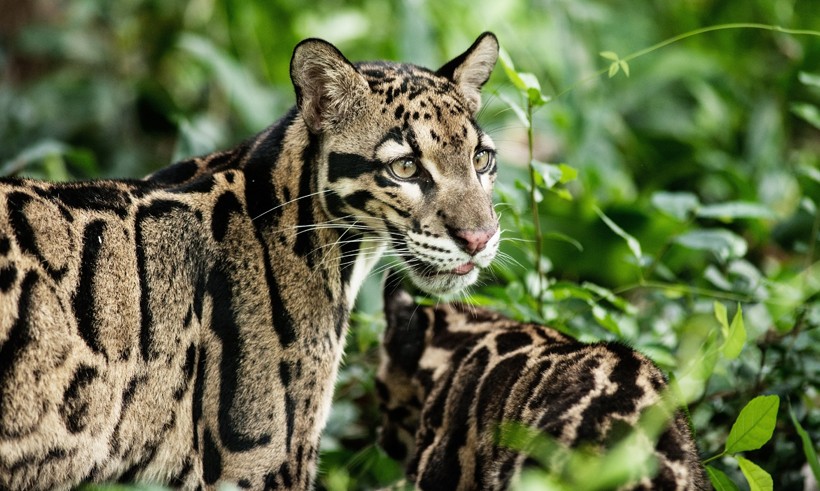
The color of the clouded leopard provide perfect camouflage in its woodland habitat
?
Image credits: Signature Message/Shutterstock
Clouded leopards have a gray, brown and black colored fur with large patches. The color of its skin and its large patches provide perfect camouflage in its woodland habitat. When compared with other big cats, the clouded leopard is the smallest.
It has a body length of up to 1.5-1.8 meter (5 to 6 feet) and the shoulder height ranges from 30 to 50 cm. Up to half of the entire body length is the tail, which can be up to 90 cm in length. The long and strong tail acts as a counterweight and allows the clouded leopard to climb and leap with extraordinary precision.
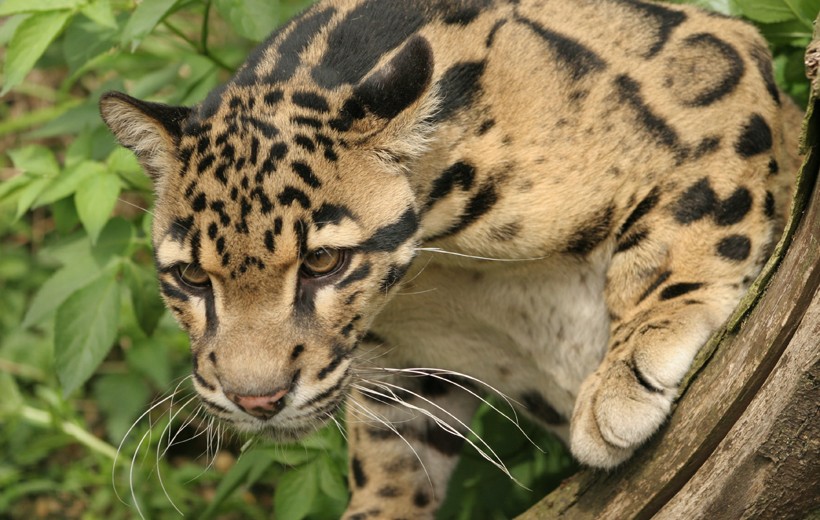
Clouded leopard, smallest of all big cats
?
Image credits: Victoria Hillman/Shutterstock
The clouded leopards have exceptional senses of vision, smell and hearing. It has one of the most unique set of eyes in the entire cat family. Instead of vertical slit pupils like small cats or round pupils found in big cats, the clouded leopard has oblong shaped pupils. Their canines are very long and they also have a strong jaw.
Subspecies
The species N. Nebulosa is split into three recognized subspecies. The nominate subspecies N. n. Nebulosa inhabits forest ranges between Southern China and Easter Myanmar while the subspecies N. n. macrosceloides occurs between Nepal and Myanmar in Southeast Asia. The third subspecies, N. n. brachyura, also known as the Formosan clouded leopard, occurred in Taiwan. The subspecies is currently considered extinct as there were no reported sightings since the early 1990s. The N. n. brachyura was easily distinguishable from the other two subspecies due to its short tail. Other physical characteristics were quite similar.
The sister species Neofelis diardi, also known as the Sunda clouded leopard, was once recognized as a subspecies of Neofelis Nebulosa. However, later studies revealed that the Sunda clouded leopard and the Neofelis Nebulosa are sister species that split from a common ancestor approximately 1.4 million years ago. Thus, in 2006 the Neofelis diardi was classified as a separate species of genus Neofelis. It is highly difficult to distinguish between subspecies and species of the genus Neofelis. As there are no visible differences, wildlife experts determine the species according to their location of occurrence.
Habitat
Clouded leopards prefer tropical forests, jungles and woodlands due to the rich availability of prey in such habitats. As their hind paws can bend and rotate up to a certain extent, the clouded leopards can climb down tree trunks with their head first. In captivity, they have been observed hanging from branches by bending the hind paws and wrapping the long tail on the branch.
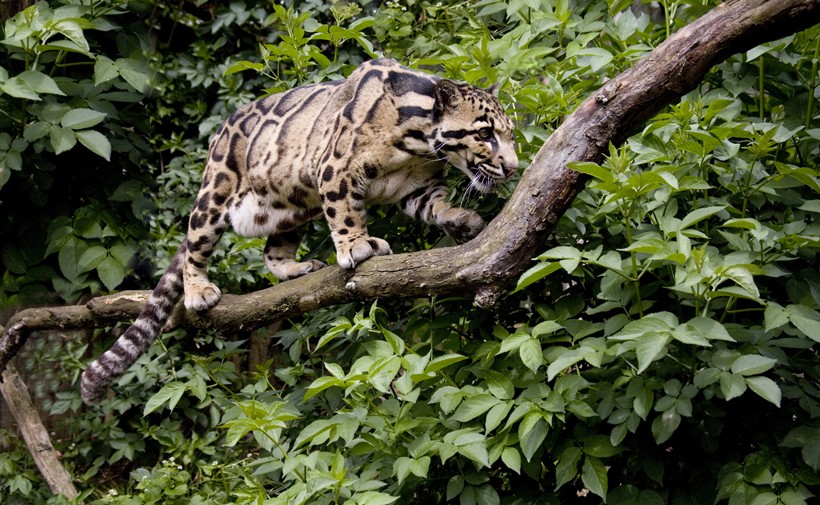
Clouded leopard walking on a branch
?
Image credits: glen gaffney/Shutterstock
The exceptional ability to climb allows the clouded leopard to hunt both terrestrial as well as arboreal prey animals. Small-sized animals like pigs, monkeys, rabbits, birds, rodents and squirrels are all considered to be prey for the clouded leopard. On the other hand, they are frequently challenged by larger predators like tigers, leopards and humans.
"Clouded leopards are very efficient climbers, capable of hanging from branches by their hind paws."
During hunting, the mammal usually stalks to get closer and finishes off with a sprint to catch the unsuspecting prey. Their patchy brown fur provides perfect camouflage as the forest grounds are usually covered with dry leaves. Trees are frequently used while stalking the prey and when it’s not hunting, the clouded leopard uses the safety of treetops to rest and sleep.
Reproduction and Life Cycle
Clouded leopards reach sexual maturity 25 to 26 months after birth. In captivity, mating usually occurs between December and March whereas in the wild, they mate any time of the year. During the mating season, males and females look out for each other by following the scents left by them. Males are highly aggressive during mating. They are known to bite the female during copulation, sometimes injuring the female fatally. A couple stays together for a few days and will mate multiple times during this period.
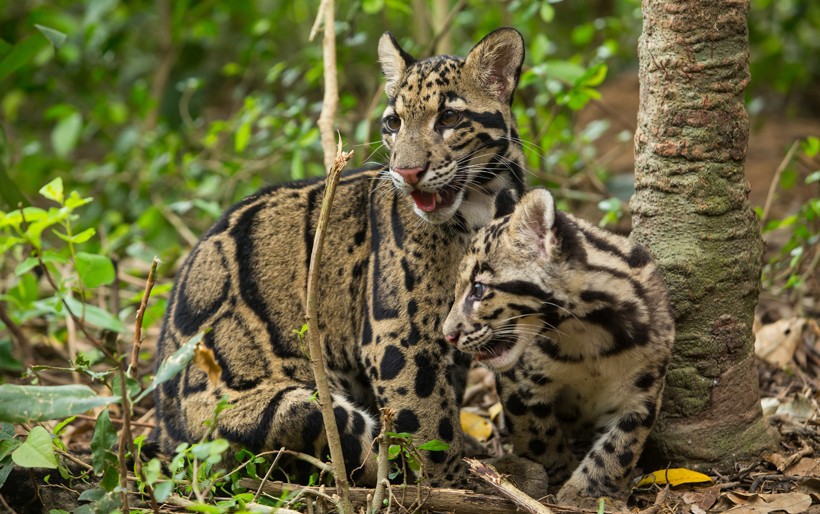
Clouded leopard mother with cub
?
Image credits: surassawadee/Shutterstock
After mating, the male leaves the female and may continue to mate with other females. The female, after a gestation period of up to 100 days, gives birth to 1 to 5 small cubs. The cubs are blind at birth and are completely dependent on their mother. The cubs have complete dark spots and weigh up to 250 grams at birth. The eyes open within the first 10 days and the cubs are completely weaned during 3 months after birth.
The female probably hides the cubs in bushes and dense vegetation before she sets out to hunt. At 6 months of age, the cub’s fur pattern changes and becomes similar to that of adults. Most cubs start their independent life at an age of 10 months. The survival rate of the cubs is extremely low as they face many challenges in the wild. The mother has to hide the cubs and constantly hunt for them, leaving them vulnerable to predation. Lack of prey is also one of the major threats for clouded leopard cubs. Many cubs die before reaching adulthood as they succumb to starvation.
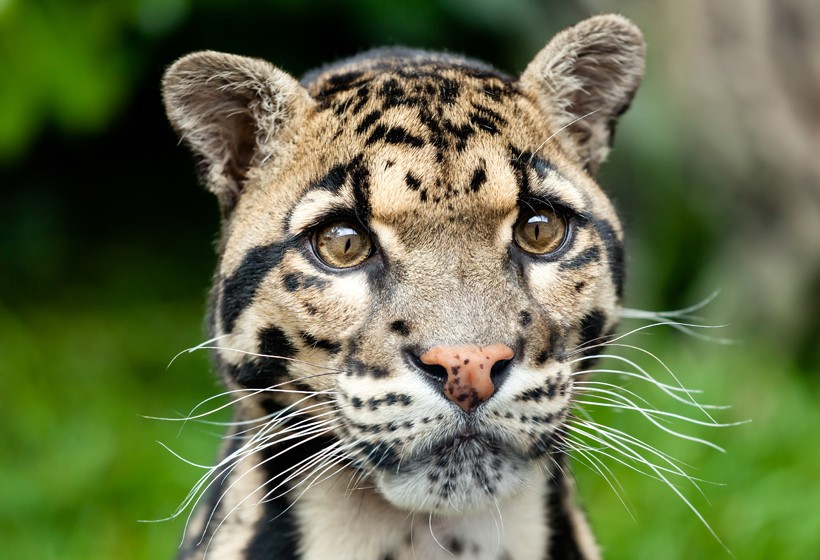
Clouded leopard have oblong pupils
?
Image credits: Sarah Cheriton-Jones/Shutterstock
Most of the reproduction and mating behavior is understood by observing captive individuals. Wild sightings are extremely rare, hence it is extremely difficult to understand their behavior in the wild.
Behavior and Communication
Clouded leopards prefer a solitary lifestyle, while mothers and cubs being an exception. Based on their behavior in captivity, it is understood that clouded leopards scent mark their territory by urinating and rubbing the head on objects. Their daily behavior in the wild is still a mystery because of the secretive lifestyle of clouded leopards.
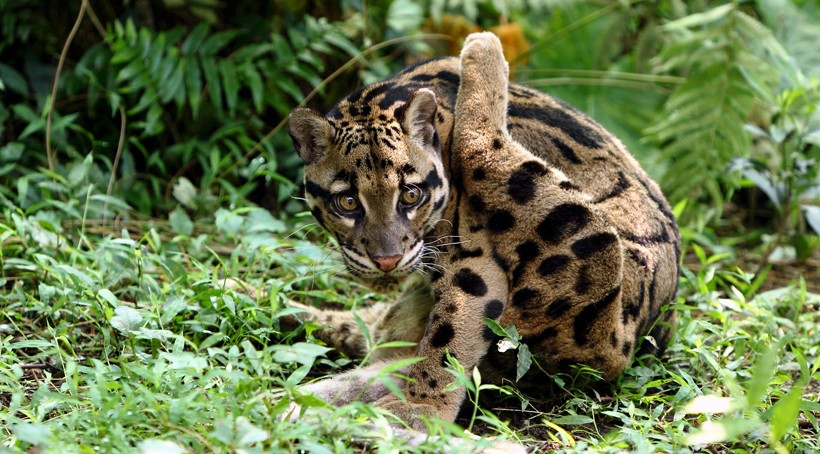
Clouded leopard grooming himself
?
Image credits: topimages/Shutterstock
Communication is rarely observed in the wild; however, individuals in captivity exhibit a wide range of vocalizations. Meows and low snorting sounds called prusten are the most commonly used close contact calls. Growling and hissing are used to send out a clear warning to intruders of their territory. The loud call made by clouded leopards can be heard at a distance of more than 100 meters. It is an extended, high-pitched version of the meowing call, usually made when the clouded leopard is looking for a partner.
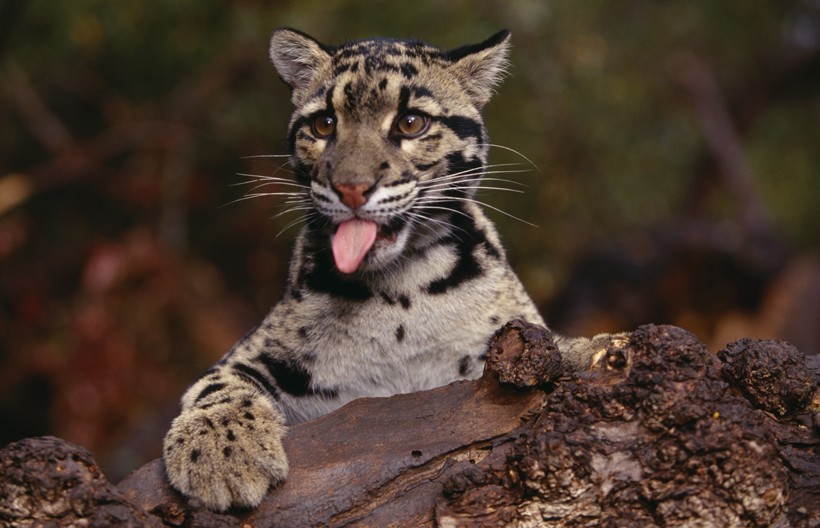
The species Neofelis is an evolutionary link between small and big cats.
?
Image credits: Volt Collection/Shutterstock
Clouded leopards display a high level of intelligence, especially in their hunting behavior. They can quickly improvise the hunting strategy according to the conditions. The ability to hunt terrestrial and arboreal creatures indicates that the clouded leopard understands its natural habitat with great precision. Based on these factors, the problem-solving clouded leopard can be termed as a highly intelligent predator of Southeast Asia.
Population and Conservation
Clouded leopards are found in India, Nepal, Bhutan, Myanmar, Indochina, Peninsular Malaysia, Thailand and China. They inhabit the Southeast Asian tropical forests and woodlands at elevations of up to 8000 ft. However, clouded leopards are extremely rare throughout its vast range. Due to their secretive nature, researchers have no idea about the exact population numbers in the wild. The IUCN survey held in 2008 concluded that the population of clouded leopards is dropping in numbers and thus, it is listed as ‘Vulnerable’, in the IUCN Red List of Threatened Species.
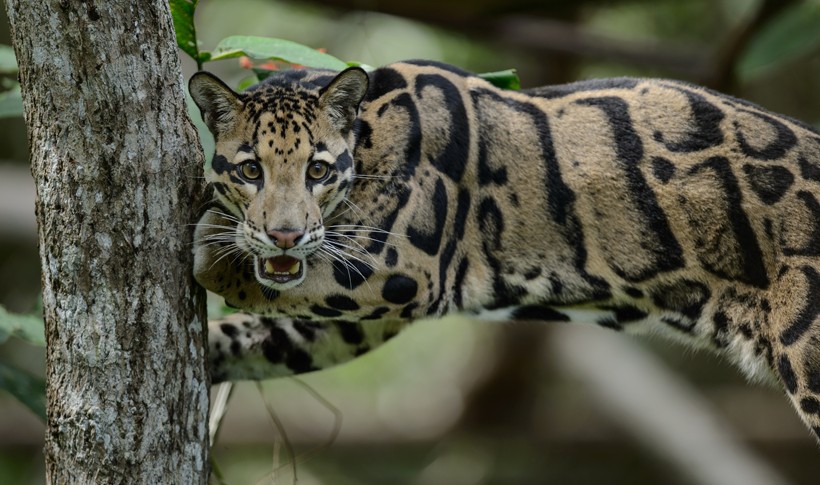
Clouded leopards are very efficient climbers, capable of hanging from branches by their hind paws.
?
Image credits: Signature Message/Shutterstock
Illegal trade, poaching and deforestation are major threats that affect the population of clouded leopards. Illegal trade has been documented in several countries along the clouded leopard’s range of distribution. Skin, bones, teeth and several other body parts have been observed in the market surveys done by conservationists. The Southeast Asian woodlands are known for its fast rate of deforestation. The rapidly decreasing range also causes lack of prey animals and this probably results in several deaths due to starvation.
The camouflaged and shy-natured clouded leopard is rarely spotted in the wild. Though several camera traps and field surveys have been done, researchers have found only limited information about the predator. Due to this, the conservation efforts have also been limited and only moderately effective. Attempts have been made for the protection of clouded leopard habitat but researchers believe that as long as hunting and illegal trade are not stopped completely, the clouded leopard might go extinct in near future.
Evolution
Clouded leopards are the smallest of all big cats, but still bigger than the small cats. Several adaptations indicate that the clouded leopard is a very important link in the evolution of big cats from their smaller ancestors. Clouded leopards belong to the family Felidae. According to fossil evidence, the oldest known member of family Felidae was the Proailurus, which occurred during the late Oligocene and early Miocene period.
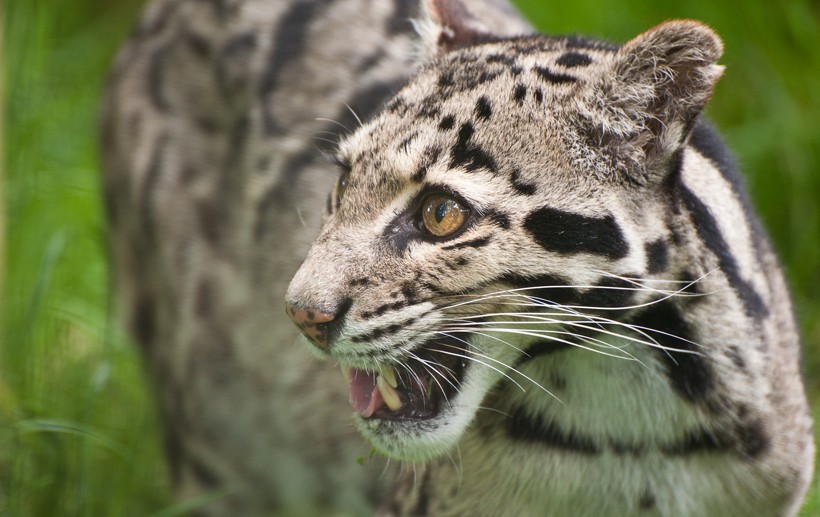
Clouded leopards are the smallest of all big cats, but still bigger than the small cats.
?
Image credits: Matt Gibson/Shutterstock
Approximately 6 to 10 million years ago, the subfamily Pantherinae diverged from Felidae and made way for the modern big cats. The species Neofelis is an evolutionary link between small and big cats. Until as late as 2006, the Sunda clouded leopard was considered a subspecies of the Neofelis Nebulosa. However, it was later confirmed that the Neofelis Nebulosa and Neofelis diardi are sister species that split approximately 1.4 million years ago from their common ancestor.
Funfacts
- The clouded leopard is the smallest of all big cats but still larger than the largest of all small cats.
- They are very efficient climbers, capable of hanging from branches by their hind paws.
- The clouded leopard’s pupils are not round like that of other big cats nor vertical slits like that of small cats. Instead, they have oblong pupils.
- Their tail can be as long as the length of its entire body. The long tail helps in climbing and leaping.
- Males do not take part in parenting.
- The antagonist of the animated film ‘Rugrats Go Wild’ is a clouded leopard.
- Clouded leopards can climb down a tree with their head first.
- Hunting clouded leopards was considered a taboo among the Rukai community people of Taiwan. However, the subspecies in Taiwan is now extinct.
